Chapter 4 The Earth’s Motions: The Earth’s Rotation Introduction :
The Earth’s Motions:
The ancient people used to think that the Earth is a static body and that the Sun, Stars and other heavenly bodies are revolving around it. But the Earth is not stationary in the universe.
Now we have come to know from scientists that the Earth is spinning around its own axis from west to east in front of the Sun. It was only in 476 AD, the great Indian astronomer and philosopher, Aryabhatta came to know that the Earth is a revolving body in space and it is revolving around the Sun.
“WBBSE class 6 physical geography chapter 4 notes”
This idea of the great Indian scientist influenced the thoughts of the scientists of the later ages all over the world. A polish astronomer, Nicholus Copernicus in 1543 A.D, Galilio Galili in 1610 A.D. and Johan Capler in 1630 A.D. came with the idea to ascertain the movement of planets and stars of the universe.
Read and Learn More WBBSE Notes For Class 6 Junior School Geography
The Earth has three basic movements, namely ‘Galactic movement’, ‘rotation’ and ‘revolution’. The galactic movement is the movement of the Earth with the Sun and the rest of the Solar System in an orbit around the centre of the milky way galaxy.
The movement has little effect on the changing environment of the Earth. So both these few motions-rotation and revolutions are of vital interest to the geographer.
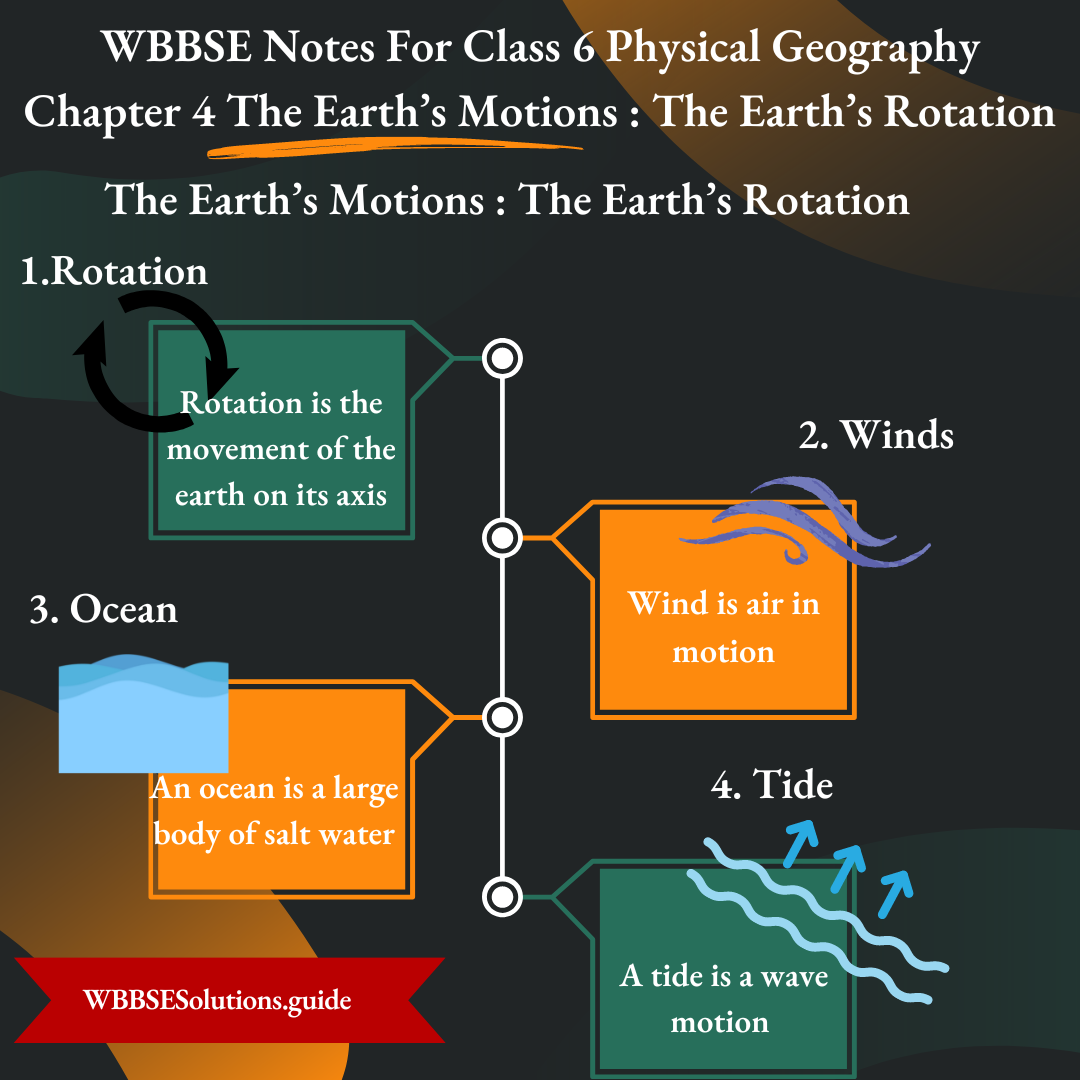
The Daily apparent movement of the Sun :
The Rotation of the Earth :
Every morning we see the Sun rising in the east and every evening we see it setting in the west. Throughout the year sun appears to be making a journey across the sky from east to west.
We say that the Sun ‘appears’ to make a journey because.e actually it is not the Sun that is moving from east to. west, but it is the Earth that is turning from west to east on its axis. To a person sitting inside a moving train, it appears as if everything outside i.e. the trees, the fields and the houses are moving backwards.
| Class 6 History | Class 6 Social Science |
| Class 6 Geography | Class 6 Science |
| Class 6 Maths | Class 6 Science MCQs |
| Class 6 General Science | Class 6 Maths Solutions |
| Class 6 Geography | Class 6 Hindi |
Similarly, we on the Earth, notice the Sun moving from east to west though it is the Earth which is spinning from west to east. This is actually an eye illusion and is called ‘apparent movement’. While the motion of the train as well as the Earth is the actual movement.
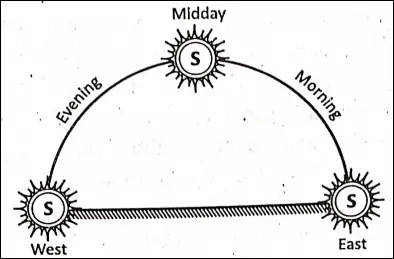
The Earth’s Rotation :
The spinning of the Earth on its own axis from west to east causing day and night is called ‘rotation’. The Earth rotates on its axis once in 24 hours (23 hours 56 minutes and 4 seconds). It is a ‘Solar day’. The movement is also known as the ‘Diurnal Motion’ or the ‘Daily movement of the Earth’.
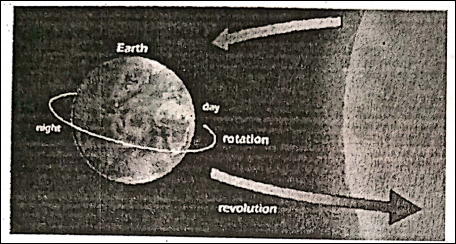
The Speed Of Rotation
The Earth is round. So its circumference is not the same everywhere. It is greatest at the Equator and it decreases gradually at the two poles.
As the circumference of different lengths rotates in the same time, their speed also varies according to their lengths. Therefore, the speed is maximum, about 1670 km/hour at the Equator.
“the earth’s motions WBBSE class 6 geography notes”
The speed at the Tropics is more than 1540 km/hour. At Kolkata (22°30’N) the speed is about 1536 km/hour. In polar regions speed of the Earth’s rotation is negligible.
Why Are We Not Flown Off The Earth’s Surface?
It is an important question in spite of the fact that the Earth is constantly moving at a great speed but why we are not thrown away into space? The reason is the gravity of the Earth.
Gravity is the force that is constantly pulling us and all things around us, towards the centre of the Earth. The existence of the gravity of the Earth was first discovered by a British Scientist, Sir Isaac Newton.
The Effects of a rotation of the Earth :
The rotation of the Earth is responsible for the following major effects
Occurrence of Day and Night:
An important effect of the rotation of the Earth is the occurrence of the day and night on every part of the Earth’s surface. The Earth is lighted by the Sun.
If the Earth is not rotating there would be no alteration of day and night-one half of the Earth would be lighted while the other half of the Earth would remain in darkness forever.
It is only due to the Earth’s rotation, all the places on the Earth enjoy day and night alternately.
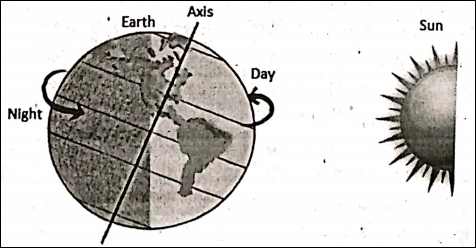
Experiment:
Keep a globe and burning candle, torch on the table. Rotate the globe and notice that the lighted half of the globe is crossing the ‘shadow circle’ and becomes dark which again, in turn, is crossing the shadow circle and coming under the light.
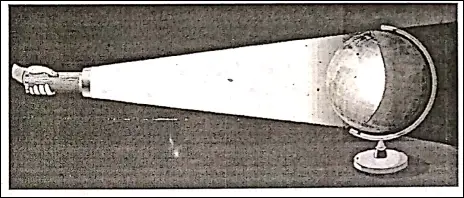
So, day and night takes place, if you think that candle/torch represents the Sun and globe represents the Earth. The circular boundary between the illuminated part and the dark part of the sphere (globe) is called the ‘Shadow Circle’ or the ‘Circle of Illumination’.
During the rotation of the globe when a particular place comes in front of the candle/ torch, it gets sunlight and therefore has a day. As the Earth rotates, their particular place moves away from the candle/torch representing of night.
“the earth’s rotation class 6 WBBSE explanation”
At position ‘a’ the place experiences morning as it emerges from darkness into daylight. At position ‘b’ when light is directly overhead, the place has its ‘Noon.’ At position ‘c’ evening starts at place ‘A’ as it passes from light into darkness.
Finally, positioned, the place has its midnight as it is directed away from the light (Sun). In this way all places on the Earth’s surface continuously get periods of daylight followed by periods of darkness.

Determination Of Directions :
The Four sides, namely east, west, north and south are fixed only on the basis of the Earth’s rotation. Rotation determines the direction in which the Sun, Moon and Stars appear to rise and set.
Creation Of Centrifugal Force :
The rotation of the Earth creates a centrifugal force which causes the Earth to have a slight bulge at the equator.
The apparent movement of the Sun, Moon, Planets and Stars :
Owing to the rotation of the Earth from west to east, the Sun, the Moon, Planets and the Stars appear to move from east to west across the sky. This apparent movement of the Sun and other heavenly bodies is in a direction opposite to that of the rotation of the Earth.
“summary of class 6 physical geography chapter 4 WBBSE”
Deflection Of Winds And Ocean Currents :
The trade winds, westerlies and ocean currents are all deflected to the right and left in the northern and southern hemispheres respectively due to the rotation of the Earth.
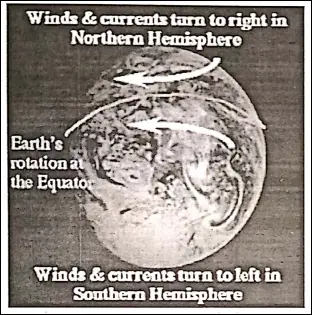
Different Local Time :
The rotation of the Earth is responsible for the difference in time between different places on the Earth. The difference in local time is 4 minutes for each degree of longitude. The places located on the same meridian have the same local time.
(7) Idea of Time :
The Earth rotates from west to east on its axis once in every day or 24 hours. It is called a “Solar day”. A day is the length of time from one Moon to the next and each day is divided into 24 hours; each hour is divided into 60 minutes and each minute is divided into 60 seconds.
“important questions from the earth’s rotation class 6”
Variation Of Day And Night :
If the Earth was flat then its surface would have only day and night. As the Earth is a sphere, there is a variation in the condition of day and night, like morning-evening, noon-midnight, dawn-dusk etc. They occur as below :
Morning and Evening :
The surface of the rotating Earth, that emerges from night to face the sunlight after crossing the “Shadow Circle” experiences morning.
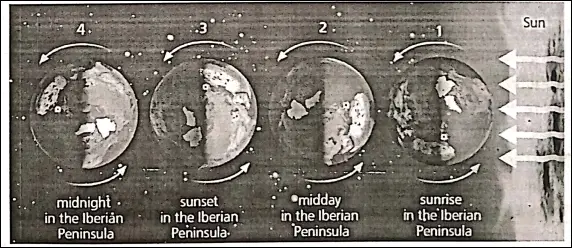
Conversely, the lighted surface on the Earth that rotates away from the Sun, approaches darkness after crossing the circle of illumination or ‘Shadow Circle’, experiences evening.
Noon And Midnight :
In the middle of the lighted half of the Earth’s surface, the Suh lies directly overhead and then it is called ‘noon’. Conversely midway in the half of darkness on the Earth’s surface, the time is midnight.
Dawn And Dusk :
The time before sunrise a faint light that lights the sky is called dawn. After sunset, the faint light that is Still Seen in the sky is called ‘dusk’ or ‘twilight’.

Flattening of the Earth at the Poles and bulging at the Equator :
The rotation of the Earth is considered responsible for the slight flattening of the Earth at the two poles and a bulging at the equator. This is because the speed of the Earth’s rotation is highest at the equatorial region and lowest towards the poles.
Occurance Of Daily Tides
High tides or flow-tides and Ebb-tides are caused because of the rotation of Earth. During rotation, the part of the Earth facing the Moon is attracted to the Moon. On that side as land is solid but water bodies are flexible, they are pulled towards the Moon, so they swell up to form high tides or flow tides.
“WBBSE class 6 geography chapter 4 key points”
At the same time on the opposite side due to the centrifugal force, indirectly high tides are also formed. In between these two zones of high tides are the two ebb¬tides or low tides. If the earth was stationary there would have been only one high or low tide.
Origin Of Plants And Animals
Due to rotation, there is optimum light and heat on the Earth’s surface for the origin of plants and animals. If there was no rotation of the Earth only one portion of the Earth would be constantly having day or night. So there would have been no variation of light or heat which is essential for the evolution of plants and animals.
Sense of Time :
The determination of time of a place depends on the rotation of the Earth. The Earth rotates 360° in 24 hours, which means it rotates 15° in 1 hour and 1° in 4 minutes. This confirms that 4 minutes time is added for each degree of longitude towards the east and subtracted for each degree of longitude towards the west.
International Date Line
A line that roughly follows the 180° meridian, with the same deviations to avoid landmasses and groups of islands is called the ‘International Date Line’ (I.D.L). The date immediately of the line is one day earlier than to the west.
This situation occurs because of the accumulated time change of one hour for each 15° of longitude west and east of.the Greenwich Meridian (0°); i.e. 180° of Greenwich is 12 hours slow but 180°E is 12 hours fast.
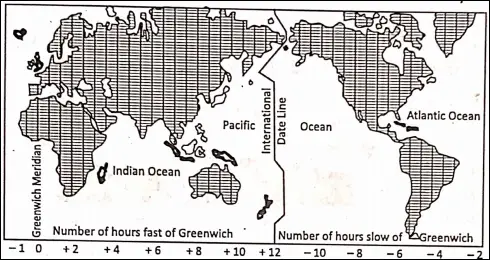
Local Time
When a meridian comes in line with the centre of the Sun, local midday is said to have occurred at all places on the meridian. Fixing time on the basis of local midday of a place is known as the local time of a place.
“what is earth’s rotation and how does it affect us”
For each degree of longitude, local time varies by 4 minutes. This means that for cities like Delhi, London, New York etc. local time will differ from one point to another from place to place within a country or from country to country.
Standard Time
In a country, local times of places at different longitudes differ from each other. If each place maintained its own time schedule based on its own local time many inconveniences would have corrupted up.
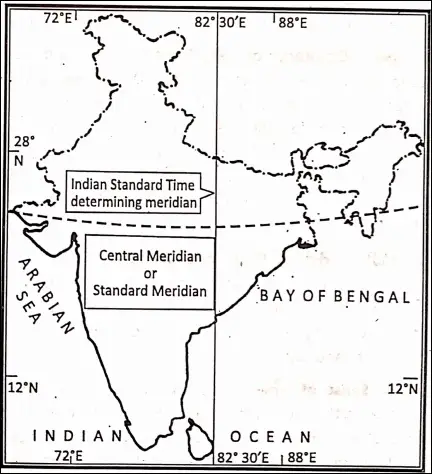
To avoid such inconveniences the local time of a central place of a country or part of a country is generally selected the time for the country (or selected region) as a whole. This time is known as- the standard time of the country (or part of the country or a scheduled region.)
I.S.T
The local time of 82°30’E (passing through near Allahabad) is selected as ‘Indian Standard Time (I.S.T.). I.S.T. is ahead of G.M.T. by 5 hours and 30 minutes. It is followed throughout the country.
G.M.T.
The local time of Greenwich (Prime Meridian or 0° meridian) is regarded as the standard time of the zone at 0° and this is called ‘Greenwich Mean Time. ‘ Or G.M.T. Astronomers call in universal times and regarded Greenwich at the reference meridian for all calculation.
“effects of earth’s rotation on day and night WBBSE”
A.M. (a.m.) and P.M. (p.m):
At any place after midnight (00: 01) and till before 12:00 noon of the next day the time is said to be Ante Meridian or in brief A.M. (a.m.).
After 12 noon (12:01) and till before 12 midnight (00:00) the time is Post Meridian or in brief P.M. (p.m.). ‘Ante’ means before and ‘Post’ means after here, i.e. the time before or after the sunrays arrive overhead the longitude, where the time is being denoted.
The time at 12 midnight or 12 noon is not denoted by P.M. or A.M. It is written as 12 midnight (00: 00) hour or 12 noon (12: 00) hours
WBBSE Notes for Class 6 Junior School Geography
- Chapter 1 The Universe and Solar System
- Chapter 2 Shape of The Earth: Is The Earth Around?
- Chapter 3 Location of a Place on The Earth’ Surface: Where You Are
- Chapter 4 The Earth’s Motion: The Earth Rotation
- Chapter 5 Water – Land – Air
- Chapter 6 The Ice Capped Continent: Antartica
- Chapter 7 Weather And Climate
- Chapter 8 Air Pollution
- Chapter 9 Noise Pollution
- Chapter 10 India
- Chapter 11 – Maps
